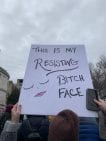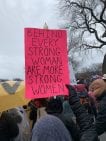On Saturday, January 18th a group of us decided to go to the Women’s March in D.C. We met the crowd at Freedom Plaza to listen to the many speakers before we marched over to surround the White House for the fourth time since the march’s inception in 2017. It was one of the coldest days since we arrived to D.C. and it began to rain, snow, and hail onto all of our pink hats, but this didn’t stop most of us for standing up for things we believe are important (and, as Minnesotans, a little cold and precipitation never stopped us, right?).
The Women’s March was proposed by a woman on Facebook named Teresa Shook. She said that because of the history of Donald Trump’s inappropriate sexual actions towards women and his election over the first female presidential nominee of a major party in U.S. history, a response from women was necessary. After thousands of women signed up to march in Washington D.C., activists and organizers began planning a large-scale event scheduled for January 21, 2017, the day after Trump’s Inauguration. Their mission statement: “to harness the political power of diverse women and their communities to create transformative social change.”1As many as 500,000 people showed up, many wearing pink clothing. One of the items of clothing included pink hats with cat ears called “pussyhats,” created to reclaim the use of the word “pussy” after Trump’s statement that he would “grab [women] by the pussy” in 2005.
 The march spread worldwide as well, with a sister march happening in all 50 states and in more than 30 countries. It was later reported that a whopping 4.1 million people participated in marches around the United States, and up to 5 million people worldwide. It was the largest single-day protest in history!
The march spread worldwide as well, with a sister march happening in all 50 states and in more than 30 countries. It was later reported that a whopping 4.1 million people participated in marches around the United States, and up to 5 million people worldwide. It was the largest single-day protest in history!
The first thing we were met with at Freedom Plaza on that rainy morning was people handing out free signs for us to hold while we marched, and we were able to get free pink hats from Planned Parenthood, who sponsors the march. We then proceeded to find the best signs that people created. Here are a few of my favorites that I was able to get a picture of:

“sisterhood is powerful”

“This is my resisting bitch face”

“Behind every strong woman are more strong women”

on the sashes: “my body,” “my choice,” “my freedom”

I believe this is to be interpreted as a vagina portrayed as a monster
This is not just a march for women’s rights though. This is intersectional feminism. We must understand, for example, that “the problem of access to health care looks different for black women, trans women, disabled women and Indigenous women, and thus policies that address health care must take into account these different impacts and experiences.”2 It also means that people are advocating for other issues alongside sexism and misogyny; we saw people holding signs and flags for LGBTQ pride, gun reform, climate change, and lots and lots of signs, chants, and props regarding the impeachment of President Trump.
It is also important to note that the first speaker we heard before the march is a part of the indigenous group whose land we were standing on, and she honored this by educating us about the land and singing a song from her native people. There were many speakers after her, including Martin Luther King III and his wife Arndrea Waters King. The last speakers talked about the protests that began in Chile for International Day for the Elimination of Violence against Women on 25 November 2019. They taught us the song that has now been performed by protesters in Mexico, Colombia, France, Spain, Turkey, and the United Kingdom, called “Un Violador en tu Camino” (A Rapist in your Path).
The English lyrics read:
Patri-archy is our judge Patri-archy is our judge It’s femicide.
That imprisons us at birth That imprisons us at birth Impu-nity for my killer.
And our punishment And our punishment It’s our disappearances.
Is the violence you DON’T see. Is the violence you CAN see. It’s rape!
And it’s not my fault, not where I was, not how I dressed. (x4)
And the rapist WAS you
And the rapist IS you
It’s the cops,
It’s the judges,
It’s the system,
It’s the president.
This oppressive state is a macho rapist.
El violador eres tú. (x4)3
While going through the lyrics in both English and Spanish and learning the movements, some marchers got antsy. Some began chanting “March! March! March!” and they pushed the crowd forward. While I appreciate the enthusiasm and eagerness to march, this was incredibly disrespectful to the women speaking. They were silencing these women of color talking about women being raped and sexually abused, which is exactly something we were protesting against.
We all finally learned to chant “el violador eres tú” before it would be performed at the White House, and we began the march.
As we marched in the rain we chanted for women, for the LGBTQ community, for climate change, for people of color, and for Trump’s impeachment. I felt honored to be a part of a force so powerful and to bring hope for those who have suffered the horrific consequences of the social injustices that have been present for too many years.
1 “Mission and Principles – Women’s March 2020.” Women’s March. https://womensmarch.com/mission-and-principles
2 “Women’s March Agenda.” Women’s March. 2019. https://static1.squarespace.com/static/5c3feb79fcf7fdce5a3c790b/t/5df275481257e772df8b6cd8/1576170878086/WM_WomensAgendaFinal_Lo_Res.pdf
3 “Lyrics and Dance: Un violador en tu camino (a rapist in your path)”. Womens March. 2020. https://womensmarch.com/2020-dance
Bibliography
“A Rapist in Your Path.” Wikipedia. December 30, 2019. https://en.wikipedia.org/wiki/A_Rapist_in_Your_Path#cite_note-larsson-6
Marissa Lang, Samantha Schmidt. “Women’s March Protesters in D.C. and across the Country Pledge It’s Only the Beginning.” The Washington Post. January 19, 2020. https://www.washingtonpost.com/local/womens-march-protests-set-for-saturday-as-organizers-pledge-its-only-the-beginning/2020/01/17/9a7186b2-3945-11ea-bb7b-265f4554af6d_story.html
“Mission and Principles – Women’s March 2020.” Women’s March. https://womensmarch.com/mission-and-principles
“Women’s March.” History.com. January 05, 2018. https://www.history.com/this-day-in-history/womens-march.
“Women’s March Agenda.” Women’s March. 2019. https://static1.squarespace.com/static/5c3feb79fcf7fdce5a3c790b/t/5df275481257e772df8b6cd8/1576170878086/WM_WomensAgendaFinal_Lo_Res.pdf
“2017 Women’s March.” Wikipedia. January 18, 2020. https://en.wikipedia.org/wiki/2017_Women’s_March.
